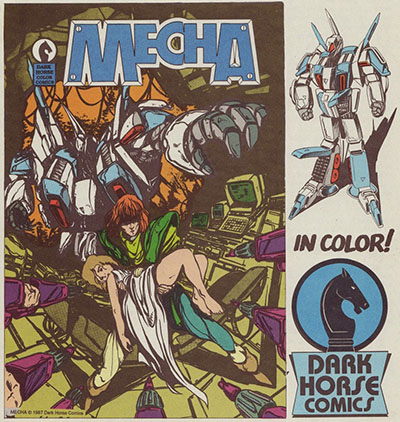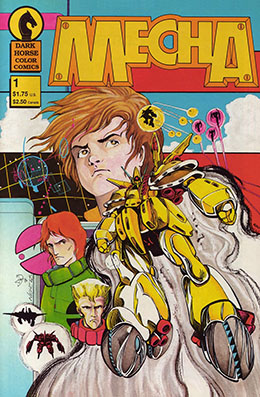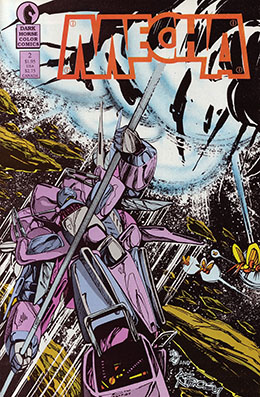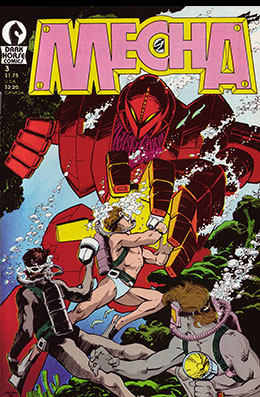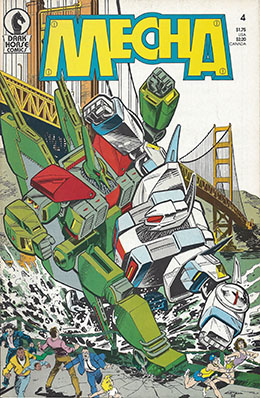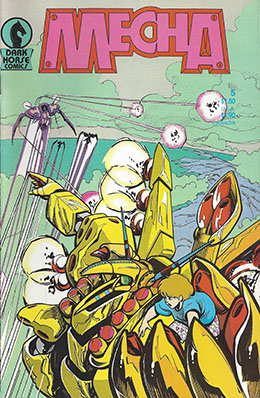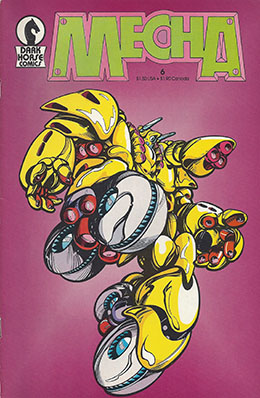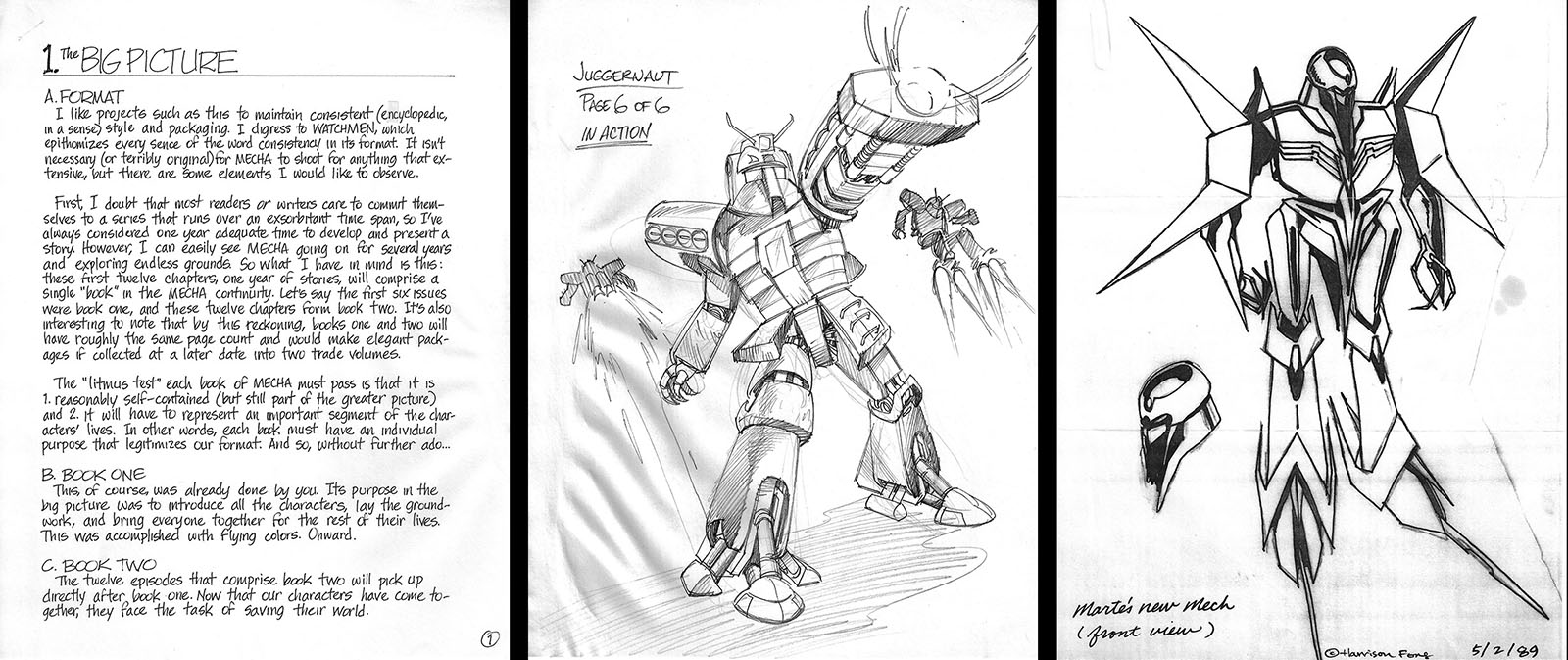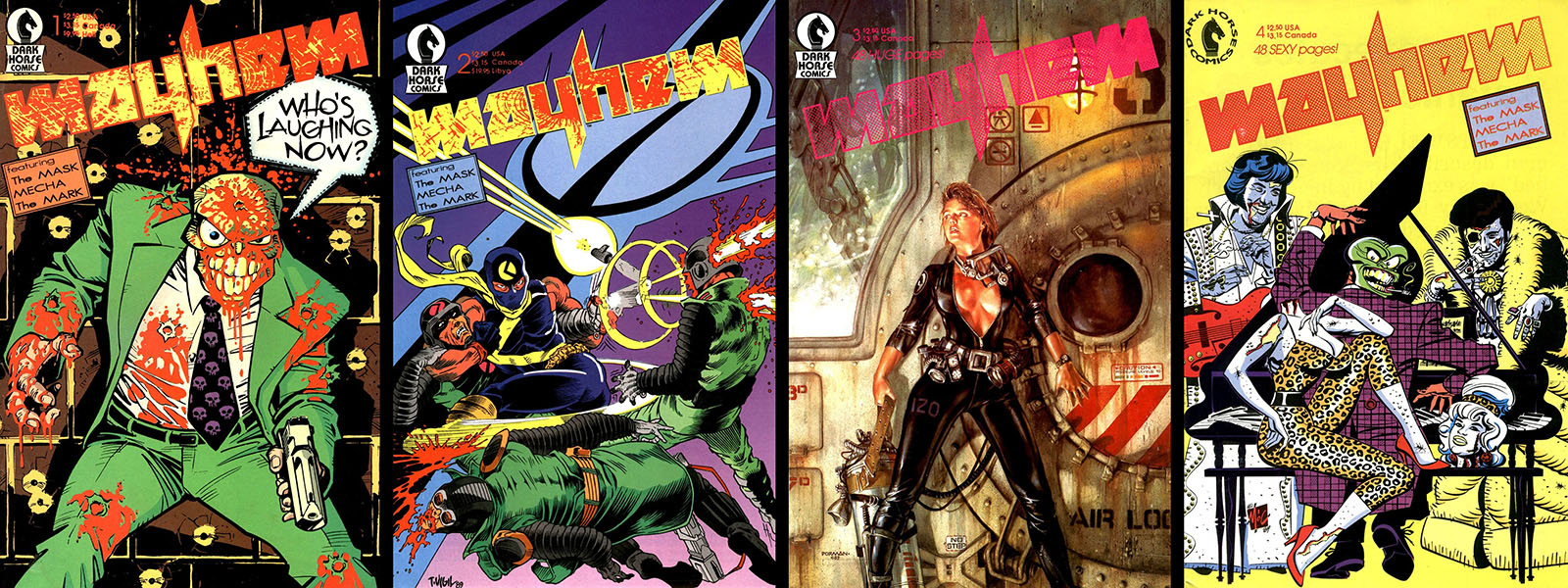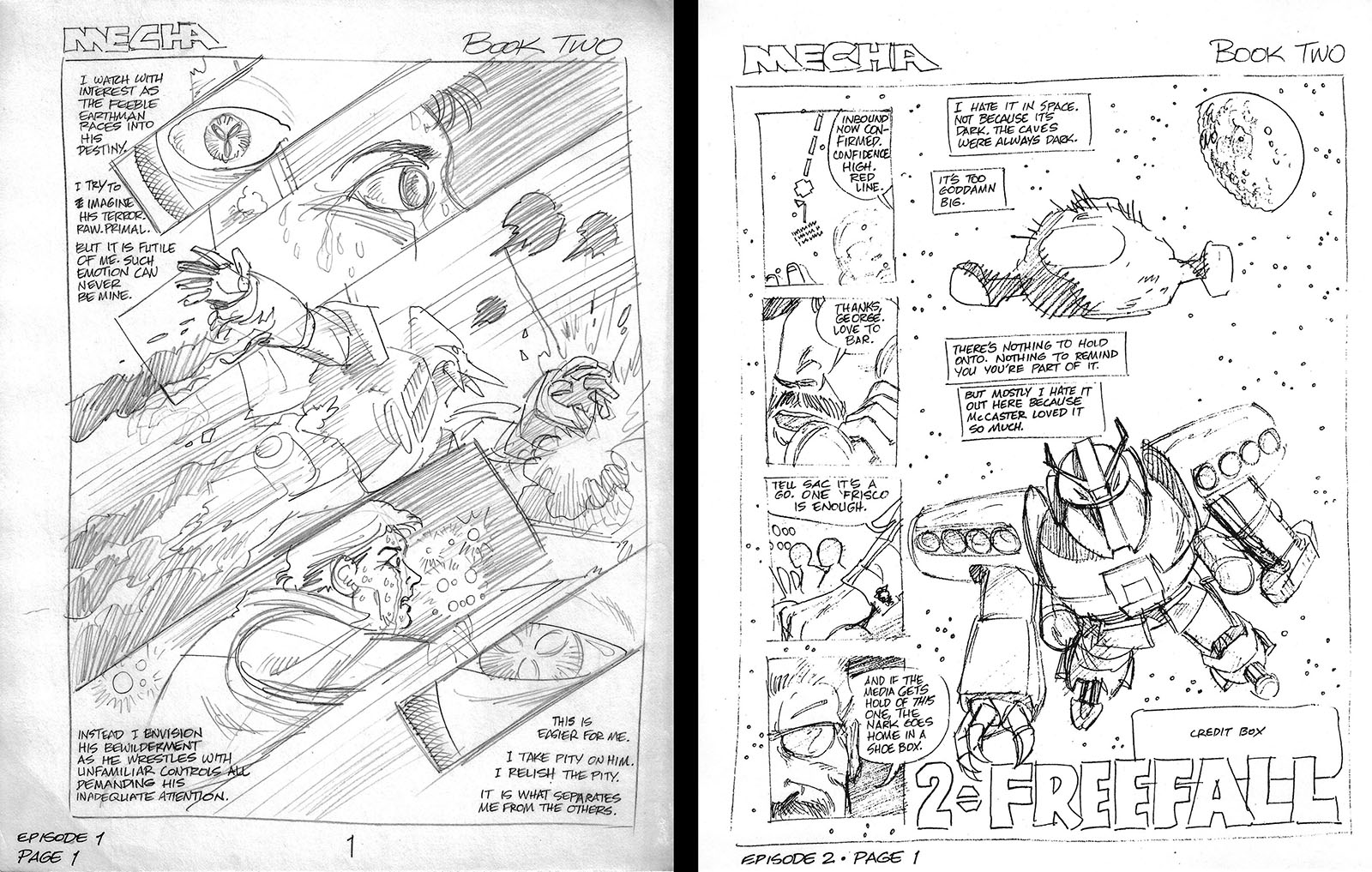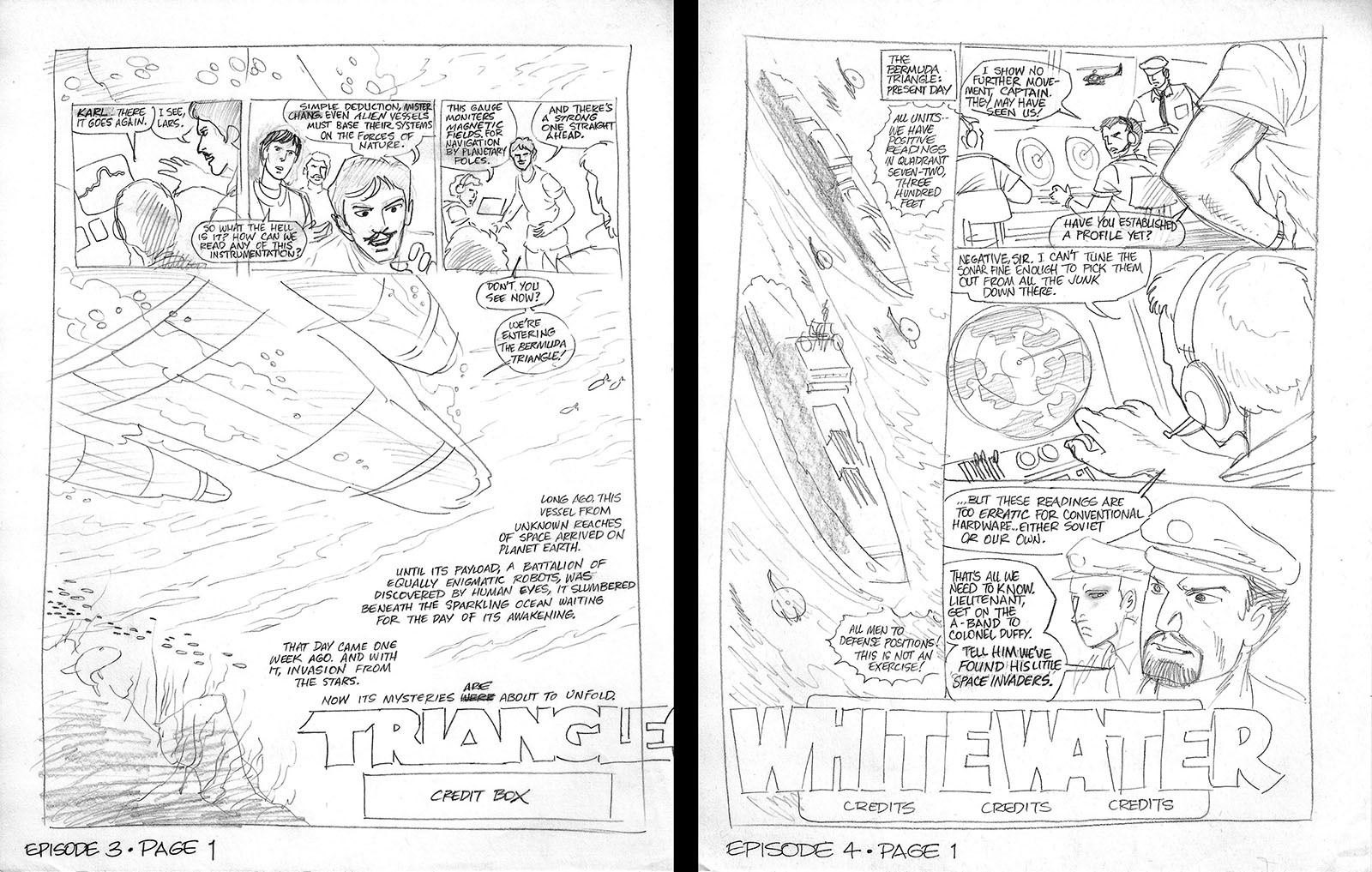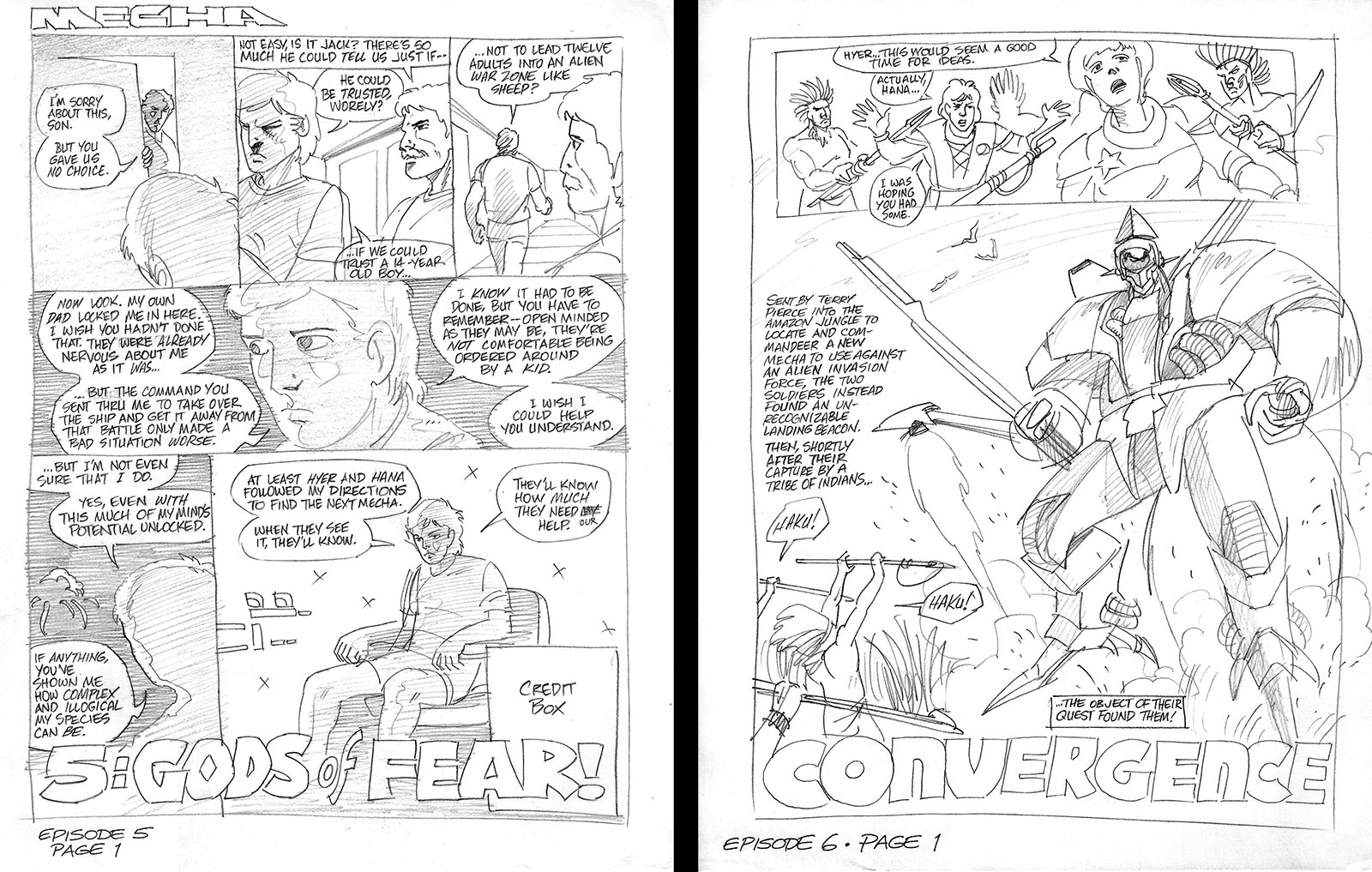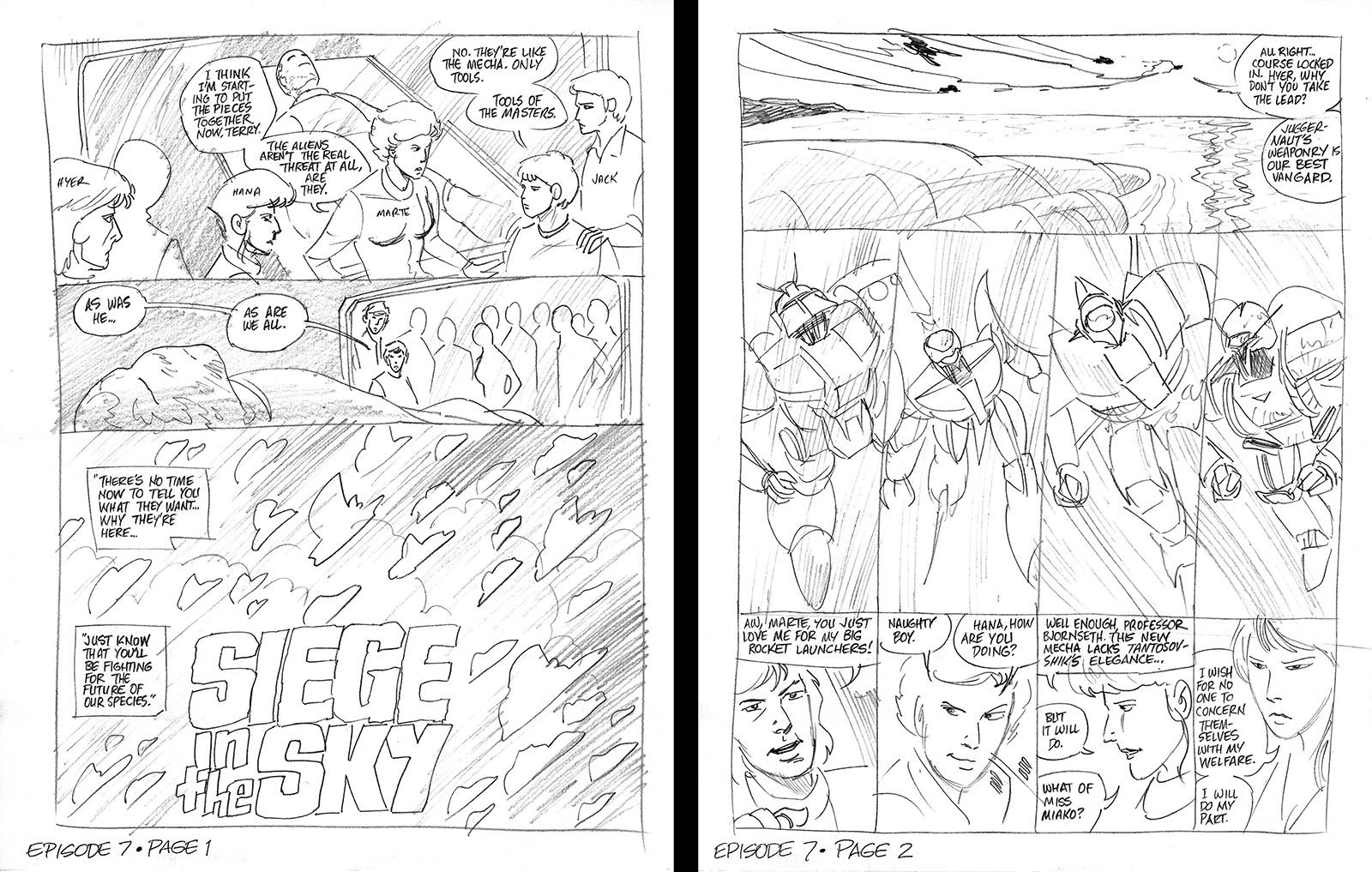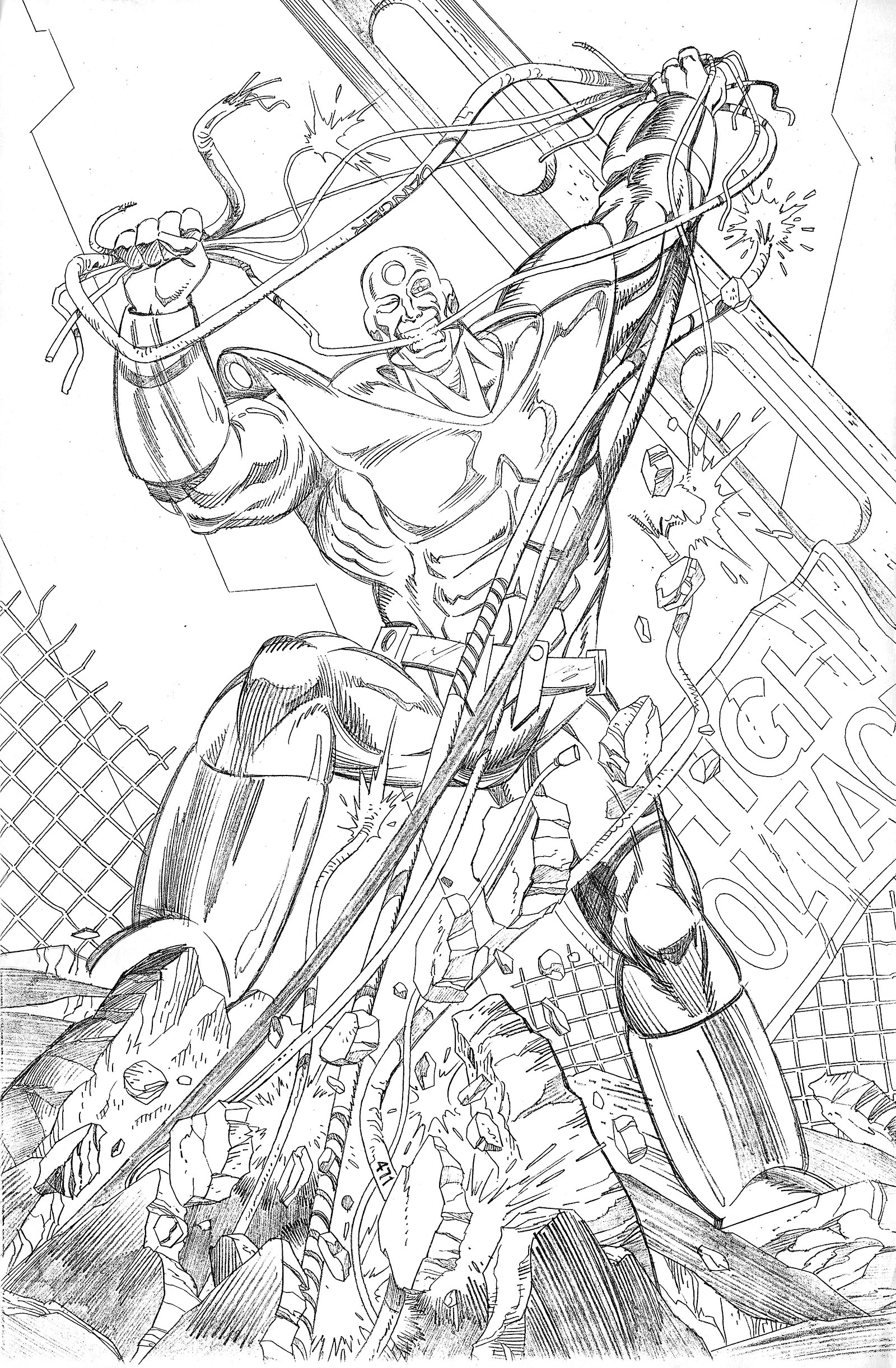MECHA, 1988/89
As it turned out, I entered the comics industry exactly the same way I entered the animation industry. I showed up with a project to pitch and someone said, “Your thing is pretty cool. Now come over here and work on my thing.”
With animation, my pitch for Grease Monkey landed me a job on my first cartoon show, Wing Commander Academy. With comics, my pitch for BROID landed me my first comic book gig, writing the followup to a Dark Horse series titled MECHA.
These were the days when Dark Horse was still a scrappy little independent company with mostly black & white comics, some raw talent that caught your eye on the stands, and a big bucket of gumption. (Read about their history on Wikipedia here.) They planted their flag in 1986, and about twenty years later they were the biggest indie publisher in the country with loads of high-visibility titles. But back in 1987, when they were still clawing their way up, they got the attention of early anime fandom when they published one of the first comics that was openly and unashamedly influenced by anime.
That comic was titled MECHA, and – primarily because it had so little competition in its chosen genre – it was an instant hit. Prior to this, the only so-called “giant robot” comics that had risen to prominence were Shogun Warriors (Marvel) and Doug Rice’s Dynamo Joe (First Comics). MECHA rode the post-Robotech wave and was visibly informed by mid-80s anime. It was most obvious in the robot designs by penciler Harrison Fong, who did not go out of his way to hide his influences.
The premise for the story is that various people around the world come into contact with mysterious, powerful machines that activate with a touch, irrevocably bonding with their discoverer. They’re loaded with seemingly inexhaustible weapons and energy – but what are they for? That question was grappled with for six issues, all of which can be read right here. (Don’t worry, they go fast; you can get through all six in under an hour.)
Like I said, the first issue was an instant hit. When that happens, it’s vital to have a second issue ready on time to capitalize on the momentum. That wasn’t the case with MECHA. Instead, production delays kept it off the shelves until four months later. The stated reason was that the color took longer than everyone expected, but then problems were compounded when the penciler sustained a wrist injury and the third issue took another six months to show up. The fourth appeared just a month later – on schedule at last – but then things got out of control again.
This was sort of where I entered the picture. I was living in Michigan in 1988, and had become a regular attendee of the Chicago Comic Con, which happened every summer around July 4 weekend. It was as close as we in the Midwest could get to the already-legendary San Diego Comic Con, and it gave me a once-in-a-year chance to hobnob with real comic book pros. I always took artwork with me and made it my task to get it in front of an editor.
Chicago Con 1988 occurred shortly after MECHA #4 was published, by which time I had written and roughed out several issues of my own “giant robot” series, BROID. Since Dark Horse was obviously open to the genre, I sought out the company’s editor-in-chief Randy Stradley, who had both co-created and written MECHA. I found him, cornered him, and gave him a look at what I was doing. MECHA #4 had just come out, and production delays were mounting again.
Randy was intrigued by BROID, enough to encourage continued contact after the convention. I sent him copies of everything I’d done so far and it put a new idea in his head. As much as he enjoyed writing MECHA, it was becoming one more thing than he could handle as the company’s EIC. He was going to write two more issues and then step away. He confided in me that he didn’t really have the rest of the story figured out, so it was wide open to interpretation. And he offered to let ME take it from there.
“Your thing is pretty cool. Now come over here and work on my thing.”
Rather than continuing as a standalone series, it was going to be folded into a monthly anthology title called Mayhem along with two other “M” titles, The Mask and The Mark. Each chapter would be 12 pages with Harrison Fong continuing as the artist. It wasn’t BROID, but it was an anime-inspired comic right in my wheelhouse for an upwardly-mobile publisher that I really wanted to work for. So yeah, I could handle that.
I specified that I wanted to work in the same style as BROID, writing the script and laying out the pages in a single step. There were no objections to this, but Chris Warner – the editor on Mayhem – insisted that I submit a script in addition to the layouts. I didn’t see much purpose in it, but I relented. Whereas Randy seemed more soft-spoken, Chris was a tough-love kind of editor who kept beginners on a tight leash. I’m the same way now when I direct a TV show with beginner storyboard artists. It keeps them from making expensive mistakes.
I don’t remember now what my thoughts were about Harrison Fong’s art on the first six issues. Looking at them today, it’s obvious that he was very inexperienced and didn’t yet have a grip on clear storytelling. He was struggling with figure drawing, which was wildly inconsistent. It was also hard to discern the form of his robots, especially when the book went to black and white and everything sort of blended together. I’m sure I recognized those problems back then, and I set out to rectify them with carefully-designed panels and page layouts.
I appended my layouts with explanatory notes, describing why I made certain choices and how they were meant to express the narrative. But what I got back was…less than I’d hoped for. It looked just as rushed and sketchy as the previous series, despite all the information I provided. No amount of nuance was going to get through. But I kept at it anyway. This was my first professional comic book, and I was going to work at the top of my skill level so that it wouldn’t end up being my last.
Regrettably, it was the last in terms of Dark Horse projects. After it was over, I stayed in touch with Randy Stradley and kept sending him proposals for new comics. Not a single one of them caught his interest and eventually I gave up trying to crack that nut. But I kept everything I did for this project, and now I can share it at last.
Intro pages
This was my proposal for where to take the story after the first series. The plan at the time was for it to last 12 chapters, and since each chapter was half the length of a comic, it would be the equivalent of another six issues. Unfortunately, we didn’t make it that far. But the whole original concept is still intact in this proposal.
My designs
Harrison Fong was the defacto robot designer for the story, but since he was still finishing out the first series, I got a head start and came up with initial designs for the sequel. That led to some back-and-forth where he modified my stuff and I tinkered with his stuff, so these sets are not strictly chronological
Harrison’s designs
Harrison had created a lot of robots for the first series, and not all of them were used up yet, so Randy Stradley sent me copies of the leftovers for consideration in the sequel. They are presented here along with newer stuff that was refined before starting on the new chapters.
Mayhem lasted four issues (May through September 1989) and then got the axe. I was working far ahead of deadlines, so I produced seven full chapters before the game was called. Chapter 7 actually brought the story to a close with a definitive ending, and since I preserved every page of it you can finally see that ending for the first time below.
Chapter 1: Deliverance
Click here for my rough layouts and notes
Click here for a PDF of the finished pages
Chapter 2: Freefall
Click here for my rough layouts and notes
Click here for a PDF of the finished pages
Even while I was writing it, there seemed to be something magical happening with Chapter 2. It focused on Hyer, originally set up as the premiere character, and investigated his past through a series of regressive flashbacks going in reverse order as he wonders what exactly brought him to this moment. I don’t know what possessed me to write it this way, but I’m still kind of amazed by it. I still consider it the best standalone chapter of my early career.
After Chapter 4, none of the content went past the rough layout stage, so you’ll only see my material. This is the ending no one ever got to read until now.
Chapter 5: Gods of Fear
After I did the layouts for this chapter, I got the word that Mayhem wasn’t doing well enough to make it all the way to the ancitipated 12 issues and it would end at issue 7 instead. Thus, I had to go back in and revise it so we’d get to the end sooner.
Click here for my rough layouts
Chapter 6: Convergence
Now that the story had to be accelerated, I had to ditch the character development and work the plot instead, following up with the revised Chapter 5 and building to a climax I didn’t expect to see until much later. Only one more chapter left, so this one had to do some fast talking.
Click here for my rough layouts
Chapter 7: Seige in the Sky
I don’t remember exactly why, but I went to 26 pages on the concluding chapter instead of 12, probably because 12 just wouldn’t be enough. I must have gotten permission with the anticipation that it would be published that way. But, of course, it never was.
Click here for my rough layouts
Postscript: In late June 1989, I returned to the Chicago Comic Con with BROID in hand and my first professional publishing credits (Mayhem #3 was out by then). I walked up to editor Chris Ulm at the Eternity Comics booth and laid it all on him. That turned out to be the true launch of my comics career, as described elsewhere on this website.
In the summer of 1990, I went to my first San Diego Comic Con (back when it was still called that) and stepped into a much larger world. I also met Harrison Fong in person, and we got along well. By that time he had wrapped up his work on a Star Blazers miniseries for Comico that looked about the same as MECHA, and he was on his way out of the comic book biz. We haven’t had any contact since then, but according to LinkedIn he’s been thriving in the video game community ever since, so good for him.
MECHA sort of made a comeback in 1993, but in name only. Now it was the title of a superhero comic from Dark Horse, even reviving the original logo as a nod to their early title. I thought maybe there was a chance that my track record could get me involved, so I drew an unsolicited pinup of the character (below) and sent it in. All I heard in response was that they weren’t looking for any help at the time. It was for the best; this MECHA was one piece of what they hoped would be an interconnected universe, but a strong industry contraction laid those plans to waste the following year. It was fun while it lasted.

